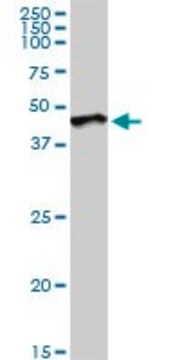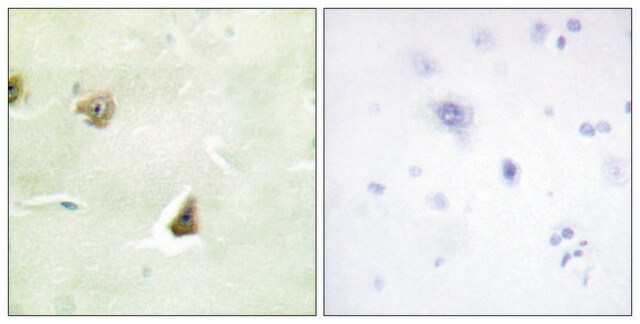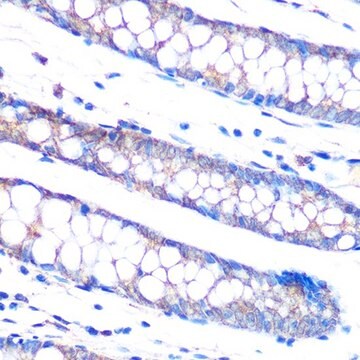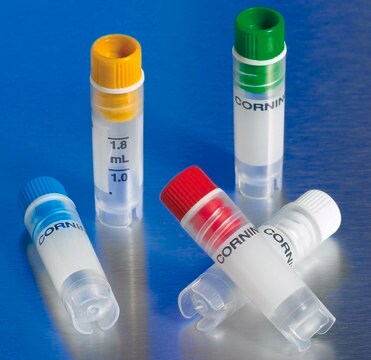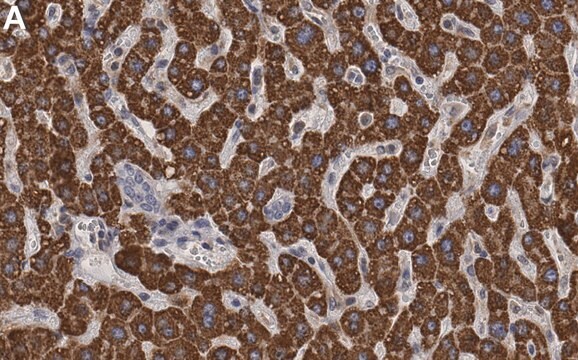推薦產品
生物源
mouse
品質等級
共軛
unconjugated
抗體表格
purified immunoglobulin
抗體產品種類
primary antibodies
無性繁殖
3G2, monoclonal
形狀
buffered aqueous solution
物種活性
human
技術
immunofluorescence: suitable
immunohistochemistry (formalin-fixed, paraffin-embedded sections): suitable
indirect ELISA: suitable
western blot: 1-5 μg/mL
同型
IgG1κ
GenBank登錄號
UniProt登錄號
運輸包裝
dry ice
儲存溫度
−20°C
目標翻譯後修改
unmodified
基因資訊
human ... DUSP6(1848)
一般說明
The protein encoded by this gene is a member of the dual specificity protein phosphatase subfamily. These phosphatases inactivate their target kinases by dephosphorylating both the phosphoserine/threonine and phosphotyrosine residues. They negatively regulate members of the mitogen-activated protein (MAP) kinase superfamily (MAPK/ERK, SAPK/JNK, p38), which are associated with cellular proliferation and differentiation. Different members of the family of dual specificity phosphatases show distinct substrate specificities for various MAP kinases, different tissue distribution and subcellular localization, and different modes of inducibility of their expression by extracellular stimuli. This gene product inactivates ERK2, is expressed in a variety of tissues with the highest levels in heart and pancreas, and unlike most other members of this family, is localized in the cytoplasm. Two transcript variants encoding different isoforms have been found for this gene. (provided by RefSeq)
免疫原
DUSP6 (AAH03143, 1 a.a. ~ 381 a.a) full-length recombinant protein with GST tag. MW of the GST tag alone is 26 KDa.
Sequence
MIDTLRPVPFASEMAISKTVAWLNEQLELGNERLLLMDCRPQELYESSHIESAINVAIPGIMLRRLQKGNLPVRALFTRGEDRDRFTRRCGTDTVVLYDESSSDWNENTGGESLLGLLLKKLKDEGCRAFYLEGGFSKFQAEFSLHCETNLDGSCSSSSPPLPVLGLGGLRISSDSSSDIESDLDRDPNSATDSDGSPLSNSQPSFPVEILPFLYLGCAKDSTNLDVLEEFGIKYILNVTPNLPNLFENAGEFKYKQIPISDHWSQNLSQFFPEAISFIDEARGKNCGVLVHCLAGISRSVTVTVAYLMQKLNLSMNDAYDIVKMKKSNISPNFNFMGQLLDFERTLGLSSPCDNRVPAQQLYFTTPSNQNVYQVDSLQST
Sequence
MIDTLRPVPFASEMAISKTVAWLNEQLELGNERLLLMDCRPQELYESSHIESAINVAIPGIMLRRLQKGNLPVRALFTRGEDRDRFTRRCGTDTVVLYDESSSDWNENTGGESLLGLLLKKLKDEGCRAFYLEGGFSKFQAEFSLHCETNLDGSCSSSSPPLPVLGLGGLRISSDSSSDIESDLDRDPNSATDSDGSPLSNSQPSFPVEILPFLYLGCAKDSTNLDVLEEFGIKYILNVTPNLPNLFENAGEFKYKQIPISDHWSQNLSQFFPEAISFIDEARGKNCGVLVHCLAGISRSVTVTVAYLMQKLNLSMNDAYDIVKMKKSNISPNFNFMGQLLDFERTLGLSSPCDNRVPAQQLYFTTPSNQNVYQVDSLQST
外觀
Solution in phosphate buffered saline, pH 7.4
法律資訊
GenBank is a registered trademark of United States Department of Health and Human Services
免責聲明
Unless otherwise stated in our catalog or other company documentation accompanying the product(s), our products are intended for research use only and are not to be used for any other purpose, which includes but is not limited to, unauthorized commercial uses, in vitro diagnostic uses, ex vivo or in vivo therapeutic uses or any type of consumption or application to humans or animals.
未找到適合的產品?
試用我們的產品選擇工具.
儲存類別代碼
10 - Combustible liquids
閃點(°F)
Not applicable
閃點(°C)
Not applicable
個人防護裝備
Eyeshields, Gloves, multi-purpose combination respirator cartridge (US)
Shinichi Hayashi et al.
PLoS genetics, 12(6), e1006138-e1006138 (2016-06-29)
Gli3 is a major regulator of Hedgehog signaling during limb development. In the anterior mesenchyme, GLI3 is proteolytically processed into GLI3R, a truncated repressor form that inhibits Hedgehog signaling. Although numerous studies have identified mechanisms that regulate Gli3 function in
Maria A Missinato et al.
Development (Cambridge, England), 145(5) (2018-02-16)
Zebrafish regenerate cardiac tissue through proliferation of pre-existing cardiomyocytes and neovascularization. Secreted growth factors such as FGFs, IGF, PDGFs and Neuregulin play essential roles in stimulating cardiomyocyte proliferation. These factors activate the Ras/MAPK pathway, which is tightly controlled by the
Peidong Han et al.
Cell research, 24(9), 1091-1107 (2014-08-16)
While the adult human heart has very limited regenerative potential, the adult zebrafish heart can fully regenerate after 20% ventricular resection. Although previous reports suggest that developmental signaling pathways such as FGF and PDGF are reused in adult heart regeneration
我們的科學家團隊在所有研究領域都有豐富的經驗,包括生命科學、材料科學、化學合成、色譜、分析等.
聯絡技術服務